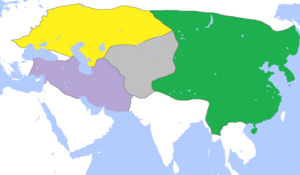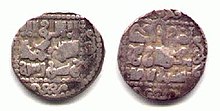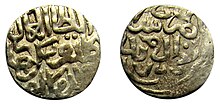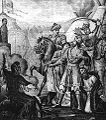Golden Horde
Golden Horde اولوغ اولوس | |||||||||||||||||||||||||||||
|---|---|---|---|---|---|---|---|---|---|---|---|---|---|---|---|---|---|---|---|---|---|---|---|---|---|---|---|---|---|
| 1242–1502[1] | |||||||||||||||||||||||||||||
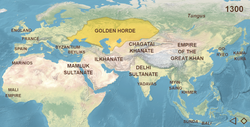 Territories of Golden Horde as of 1300 | |||||||||||||||||||||||||||||
| Status |
| ||||||||||||||||||||||||||||
| Capital | |||||||||||||||||||||||||||||
| Common languages | |||||||||||||||||||||||||||||
| Religion |
| ||||||||||||||||||||||||||||
| Government | Semi- Khan | | |||||||||||||||||||||||||||
• 1226–1280 | Orda Khan (White Horde) | ||||||||||||||||||||||||||||
• 1242–1255 | Batu Khan (Blue Horde) | ||||||||||||||||||||||||||||
• 1379–1395 | Tokhtamysh | ||||||||||||||||||||||||||||
• 1459–1465 | Mahmud bin Küchük (Great Horde) | ||||||||||||||||||||||||||||
• 1481–1502 | Sheikh Ahmed | ||||||||||||||||||||||||||||
| Legislature | Kurultai | ||||||||||||||||||||||||||||
| Historical era | Late Middle Ages | ||||||||||||||||||||||||||||
• Established | 1242 | ||||||||||||||||||||||||||||
• Blue Horde and White Horde united | 1379 | ||||||||||||||||||||||||||||
• Disintegrated into Great Horde | 1466 | ||||||||||||||||||||||||||||
| 1480 | |||||||||||||||||||||||||||||
• Sack of Sarai by the Crimean Khanate | 1502[1] | ||||||||||||||||||||||||||||
| Area | |||||||||||||||||||||||||||||
| 1310 | |||||||||||||||||||||||||||||
| |||||||||||||||||||||||||||||
| |||||||||||||||||||||||||||||
The Golden Horde, self-designated as Ulug Ulus (
After the death of
The khanate experienced violent internal political disorder known as the
Name
The name Golden Horde is a
The Turkic word orda means "palace", "camp" or "headquarters", in this case the headquarters of the khan, being the capital of the khanate, metonymically extended to the khanate itself. The English word "horde", in the sense of a large (and often threatening) group, emerged later, metaphorically extended from the reputation of the Mongol hordes.
The appellation "Golden" is said to have been inspired by the golden color of the tents the Mongols lived in during wartime, or an actual golden tent used by
It was not until the 16th century that Russian chroniclers begin explicitly using the term to refer to this particular successor khanate of the Mongol Empire. The first known use of the term, in 1565, in a Russian chronicle called History of Kazan, applied it to the Ulus of Batu, centered on Sarai.[13][14] In contemporary Persian, Armenian and Muslim writings, and in the records of the 13th and early 14th centuries such as the Yuanshi and the Jami' al-tawarikh, the khanate was called the "Ulus of Jochi" ("realm of Jochi" in Mongolian), "Dasht-i-Qifchaq" (Qipchaq Steppe) or "Khanate of the Qipchaq" and "Comania" (Cumania).[15][16]
The eastern or left wing (or "left hand" in official Mongolian-sponsored Persian sources) was referred to as the Blue Horde in Russian chronicles and as the White Horde in
Mongol origins (1225–1241)
At his death in 1227,

Using the migration of the Cumans as their
While the
Golden Age
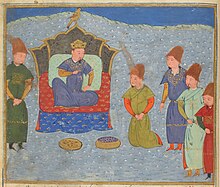
Batu Khan (1242–1256)
When the Great
All the senior princes of Rus', including Yaroslav II of Vladimir, Daniel of Galicia, and Sviatoslav III of Vladimir, acknowledged Batu's supremacy. Originally Batu ordered Daniel to turn the administration of Galicia over to the Mongols, but Daniel personally visited Batu in 1245 and pledged allegiance to him. After returning from his trip, Daniel was visibly influenced by the Mongols, and equipped his army in the Mongol fashion, his horsemen with Mongol-style cuirasses, and their mounts armoured with shoulder, chest, and head pieces.[23] Michael of Chernigov, who had killed a Mongol envoy in 1240, refused to show obeisance and was executed in 1246.[24]
When Güyük called Batu to pay him homage several times, Batu sent
In 1248, Güyük demanded Batu come east to meet him, a move that some contemporaries regarded as a pretext for Batu's arrest. In compliance with the order, Batu approached, bringing a large army. When Güyük moved westwards,
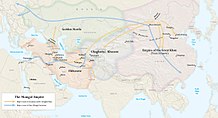
With the assistance of Batu,
With the new powers afforded to Batu by Möngke, he now had direct control over the princes of Rus'. However, Andrey II refused to submit to Batu. Batu sent a punitive expedition under Nevruy, who defeated Andrey and forced him to flee to Novgorod, then Pskov, and finally to Sweden. The Mongols overran Vladimir and harshly punished the principality. The Livonian Knights stopped their advance to Novgorod and Pskov. Thanks to his friendship with Sartaq Khan, Batu's son, who was a Christian, Alexander was installed as the grand prince of Vladimir by Batu in 1252.[31]
Berke (1258–1266)

After Batu died in 1256, his son
Ulaghchi died soon after and Batu Khan's younger brother Berke, who had been converted to Islam, was enthroned as khan of the Golden Horde in 1258.[33]
In 1256, Daniel of Galicia openly defied the Mongols and ousted their troops in northern
In 1261, Berke approved the establishment of a church in Sarai.[37]
Toluid Civil War (1260–1264)
After Möngke Khan died in 1259, the
Berke–Hulagu war (1262–1266)
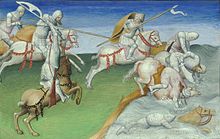
Möngke ordered the Jochid and
One of the Jochid princes who joined Hulagu's army was accused of witchcraft and sorcery against Hulagu. After receiving permission from Berke, Hulagu executed him. After that two more Jochid princes died suspiciously. According to some Muslim sources, Hulagu refused to share his war booty with Berke in accordance with Genghis Khan's wish. Berke was a devoted Muslim who had had a close relationship with the
The increasing tension between Berke and Hulagu was a warning to the Golden Horde contingents in Hulagu's army to flee. One contingent reached the Kipchak Steppe, another traversed Khorasan, and a third body took refuge in Mamluk ruled Syria where they were well received by Sultan Baybars (1260–1277). Hulagu harshly punished the rest of the Golden Horde army in Iran. Berke sought a joint attack with Baybars and forged an alliance with the Mamluks against Hulagu. The Golden Horde dispatched the young prince Nogai to invade the Ilkhanate but Hulagu forced him back in 1262. The Ilkhanid army then crossed the Terek River, capturing an empty Jochid encampment, only to be routed in a surprise attack by Nogai's forces. Many of them were drowned as the ice broke on the frozen Terek River. The outbreak of conflict was made more annoying to Berke by the rebellion of Suzdal at the same time, killing Mongol darughachis and tax-collectors. Berke planned a severe punitive expedition. But after Alexander Nevsky begged Berke not to punish his people, and the cities of Vladimir-Suzdal agreed to pay a large indemnity, Berke relented. Alexander died on his trip back in Gorodets on the Volga. He was well loved by the people and called the "sun of Suzdal".[42]

When the former
Ariq Böke had earlier placed Chagatai's grandson
Mengu-Timur (1266–1280)
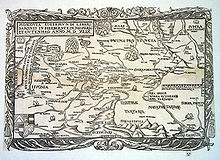
Berke left no sons, so Batu's grandson
In 1267, Mengu-Timur issued a diploma (
Mengu-Timur's word to Prince Yaroslav: give the German merchants way into your lands. From Prince Yaroslav to the people of Riga, to the great and the young, and to all: your way is clear through my lands; and who comes to fight, with them I do as I know; but for the merchant the way is clear.[54]
This decree also allowed Novgorod's merchants to travel throughout the lands of Suzdal without restraint.
In 1277, Mengu-Timur launched a campaign against the Alans north of the Caucasus. Along with the Mongol army were also some of the princes who were ordered to join him in his expedition, where they took the fortified stronghold of the Alans, Dadakov, in 1278.[58] After his Ossetian expedition, Mengu-Timur turned his attention to affairs with the Byzantine Empire and Egypt in an attempt to curb the authority of Nogai.[59] Following the death of Constantine of Bulgaria in 1277, Michael VIII and Nogai supported different candidates to the throne, leading to relations to deteriorate.[60] This led to an intervention by Mengu-Timur in Balkan affairs, in which Mengu-Timur and Metropolitan Kirill sent Bishop Theognost as their joint envoy to Michael VIII and the patriarch of Constantinople with their respective gifts and letters.[61]
Dual khanship (1281–1299)

Mengu-Timur was succeeded in 1281 by his brother
Töde Möngke made peace with Kublai, returned his sons to him, and acknowledged his supremacy.[62][63] Nogai and Köchü, Khan of the White Horde and son of Orda Khan, also made peace with the Yuan dynasty and the Ilkhanate. According to Mamluk historians, Töde Möngke sent the Mamluks a letter proposing to fight against their common enemy, the unbelieving Ilkhanate. This indicates that he might have had an interest in Azerbaijan and Georgia, which were both ruled by the Ilkhans.
In the 1270s, Nogai had raided Bulgaria,
At the same time, the influence of Nogai greatly increased in the Golden Horde. Backed by him, some princes, such as Dmitry of Pereslavl, refused to visit the court of Töde Möngke in Sarai, while Dmitry's brother Andrey of Gorodets sought assistance from Töde Möngke. Nogai vowed to support Dmitry in his struggle for the grand princely throne. On hearing about this, Andrey renounced his claims to Vladimir and Novgorod and returned to Gorodets. He returned with Mongol troops sent by Töde Möngke and seized Vladimir from Dmitry. Dmitry retaliated with the support of Mongol troops from Nogai and retook his holdings. In 1285, Andrey again led a Mongol army under a Borjigin prince to Vladimir, but Dmitry expelled them.[67]
In 1283, Mengu-Timur converted to Islam and abandoned state affairs. Rumors spread that the khan was mentally ill and only cared for clerics and sheikhs. In 1285, Talabuga and Nogai invaded Hungary. While Nogai was successful in subduing Slovakia, Talabuga stalled north of the Carpathian Mountains. Talabuga's soldiers were angered and sacked Galicia and Volhynia instead. In 1286, Talabuga and Nogai attacked Poland and ravaged the country. After returning, Talabuga overthrew Töde Möngke, who was left to live in peace. Talabuga's army made unsuccessful attempts to invade the Ilkhanate in 1288 and 1290.[68]
During a punitive expedition against the
Andrey, accompanied by a number of Rostov princes and the bishop of Rostov, went to Toqta to renew his patent and complain about Dmitry.
Nogai's daughter married a son of Kublai's niece, Kelmish, who was wife of a
After Mengu-Timur died, rulers of the Golden Horde withdrew their support from
General peace (1299–1312)
From 1300 to 1302, a severe drought occurred in the areas surrounding the Black Sea.[76] However, the troubles were soon overcome and conditions in the Golden Horde rapidly improved under Toqta's reign. After the defeat of Nogai Khan, his followers either fled to Podolia or remained under the service of Toqta, to become what would eventually be known as the Nogai Horde.[77]
Toqta established the
He demanded that the Ilkhan
In 1304, ambassadors from the Mongol rulers of Central Asia and the Yuan dynasty announced to Toqta their general peace proposal. Toqta immediately accepted the supremacy of Yuan emperor
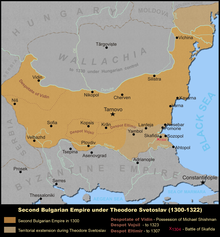
Toqta arrested the Italian residents of Sarai and besieged Caffa in 1307. The cause was apparently Toqta's displeasure at the Genoese slave trade of his subjects, who were mostly sold as soldiers to Egypt.[85] In 1308, Caffa was plundered by the Mongols.[86]
During the late reign of Toqta, tensions between princes of Tver and Moscow became violent.
Toqta organized a new conference for the princes in Pereslavl-Zalessky in the autumn of 1304, which was attended by leading princes including Andrey of Vladimir, Mikhail of Tver, and Yury of Moscow, Daniel's eldest son who succeeded him after his death in March 1304.[82] Maximos, the metropolitan of the Russian Orthodox Church, was also in attendance.[87] Toqta possibly intended to completely transform the political organization of his Russian ulus, though there is little information about the last years of his reign, with there only being accounts in the Russian annals of the interrelations among the princes, while Arab and Persian chroniclers focused on the Golden Horde's relations with Egypt and Iran.[88] Toqta probably intended to eliminate the special status of the grand principality of Vladimir, and to place all the Russian princes on the same level as his vassals with a definite appanage assigned to each one of them.[88] Toqta decided to personally visit northern Russia to settle the conflict between the princes, but he fell ill and died while crossing the Volga in 1312, according to the writer who continued Rashid al-Din's History.[88]
Islamization
Öz Beg Khan (1313–1341)
After
Öz Beg continued the alliance with the Mamluks begun by Berke and his predecessors. He kept a friendly relationship with the Mamluk Sultan and his shadow Caliph in
The Golden Horde invaded the Ilkhanate under
Öz Beg, whose total army exceeded 300,000, repeatedly raided Thrace in aid of Bulgaria's war against Byzantium and Serbia beginning in 1319. The Byzantine Empire under Andronikos II Palaiologos and Andronikos III Palaiologos was raided by the Golden Horde between 1320 and 1341, until the Byzantine port of Vicina Macaria was occupied. Friendly relations were established with the Byzantine Empire for a brief period after Öz Beg married Andronikos III Palaiologos's illegitimate daughter, who came to be known as Bayalun. In 1333, she was given permission to visit her father in Constantinople and never returned, apparently fearing her forced conversion to Islam.[95][96] Öz Beg's armies pillaged Thrace for forty days in 1324 and for 15 days in 1337, taking 300,000 captives. In 1330, Öz Beg sent 15,000 troops to Serbia in 1330 but was defeated.[97] Backed by Öz Beg, Basarab I of Wallachia declared an independent state from the Hungarian crown in 1330.[84]

With Öz Beg's assistance, the grand prince
Öz Beg's approach to Russian affairs was less constructive than that of Toqta, in which he made no attempt to change things in Russia, with his goal being to prevent the formation of a unified Russian state and to keep the balance between its princes, especially between those of Tver and Moscow.
The Mongols had undermined the strength of
A decree, issued probably by Mengu-Timur, allowing the
Jani Beg (1342–1357)

 .[112] The caption reads: "Here resides the emperor of this northern region whose empire starts in the province of Bulgaria and ends at the city of Organcio. The sovereign is named Jambech, Lord of the Sarra."[113]
.[112] The caption reads: "Here resides the emperor of this northern region whose empire starts in the province of Bulgaria and ends at the city of Organcio. The sovereign is named Jambech, Lord of the Sarra."[113]Öz Beg's eldest son Tini Beg reigned briefly from 1341 to 1342 before his younger brother, Jani Beg (1342–1357), came to power.[114]
In 1344, Jani Beg tried to seize
The Black Death of the 1340s was a major factor contributing to the economic downfall of the Golden Horde. It struck the Crimea in 1345 and killed over 85,000 people.[115]

Jani Beg abandoned his father's Balkan ambitions and backed Moscow against Lithuania and Poland. Jani Beg sponsored joint Mongol-Rus' military expeditions against Lithuania and Poland. In 1344, his army marched against Poland with auxiliaries from Galicia–Volhynia, as Volhynia was part of Lithuania. In 1349, however, Galicia–Volhynia was occupied by a Polish-Hungarian force, and the Kingdom of Galicia–Volhynia was finally conquered and incorporated into Poland. This act put an end to the relationship of vassalage between Galicia–Volhynia and the Golden Horde.[116] In 1352, the Golden Horde with its Rus' allies ravaged Polish territory and Lublin. The Polish king, Casimir III the Great, submitted to the Horde in 1357 and paid tribute in order to avoid more conflicts. The seven Mongol princes were sent by Jani Beg to assist Poland.[117]
Jani Beg asserted Jochid dominance over the Chagatai Khanate and conquered
Decline
Great Troubles (1359–1381)

Berdi Beg was killed in a coup by his brother Qulpa in 1359. Qulpa's two sons were Christians and bore the Slavic names Michael and Ivan, which outraged the Muslim populace of the Golden Horde. In 1360, Qulpa's brother Nawruz Beg revolted against the khan and killed him and his sons. In 1361, a descendant of Shiban (5th son of Jochi), was invited by some grandees to seize the throne. Khidr rebelled against Nawruz, whose own lieutenant betrayed him and handed him over to be executed. Khidr was slain by his own son, Timur Khwaja, in the same year. Timur Khwaja reigned for only five weeks before descendants of Öz Beg Khan seized power.[119]
In 1362, the Golden Horde was divided between Keldi Beg in Sarai, Bulat Temir in
By 1360, Urus Khan had set up court in Sighnaq. He was named Urus, which means Russian in Turkish language, presumably because "Urus-Khan's mother was a Russian princess... he was prepared to press his claims on Russia on that ground."[122] In 1372, Urus marched west and occupied Sarai. His nephew and lieutenant Tokhtamysh deserted him and went to Timur for assistance. Tokhtamysh attacked Urus, killing his son Kutlug-Buka, but lost the battle and fled to Samarkand. Soon after, another general Edigu deserted Urus and went over to Timur. Timur personally attacked Urus in 1376 but the campaign ended indecisively. Urus died the next year and was succeeded by his son, Timur-Melik, who immediately lost Sighnaq to Tokhtamysh. In 1378, Tokhtamysh conquered Sarai.[123]
By the 1380s, the Shaybanids and Qashan attempted to break free of the Khan's power.[citation needed]
Tokhtamysh (1381–1395)
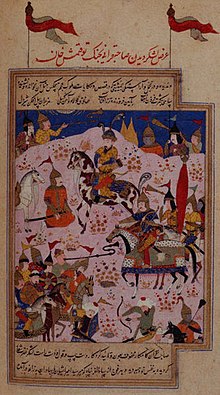
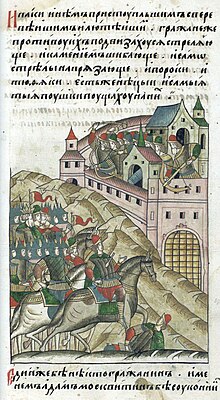
Tokhtamysh attacked Mamai, who had recently suffered a loss against Moscow, and defeated him in 1381, thus briefly reestablishing the Golden Horde as a dominant regional power. Mamai fled to the Genoese who killed him soon after. Tokhtamysh sent an envoy to the Russian states to resume their tributary status, but the envoy only made it as far as Nizhny Novgorod before he was stopped. Tokhtamysh immediately seized all the boats on the Volga to ferry his army across and commenced the Siege of Moscow (1382), which fell after three days under a false truce. The next year, most of the Russian princes once again made obeisance to the khan and received patents from him.[124] Tokhtamysh also crushed the Lithuanian army at Poltava in the next year.[125] Władysław II Jagiełło, Grand Duke of Lithuania and King of Poland, accepted his supremacy and agreed to pay tribute in return for a grant of Russian territory.[126]
Elated by his success, Tokhtamysh invaded
Edigu (1395–1419)
Temür Qutlugh was chosen Khan in Sarai while Edigu became co-ruler, and Koirijak was appointed sovereign of the White Horde by Timur.
Temür Qutlugh died in 1400 and his cousin
Disintegration and succession
Khanate of Sibir (1405)
The
Uzbek Khanate (1428)
After 1419, the Golden Horde functionally ceased to exist. Ulugh Muhammad was officially Khan of the Golden Horde but his authority was limited to the lower banks of the Volga where Tokhtamysh's other son Kepek also reigned. The Golden Horde's influence was replaced in Eastern Europe by the Grand Duchy of Lithuania, who Ulugh Muhammad turned to for support. The political situation in the Golden Horde did not stabilize. In 1422, the grandson of Urus Khan, Barak Khan, attacked the reigning khans in the west. Within two years, Ulugh, Kepek, and another claimant Dawlat Berdi, were defeated. Ulugh Muhammad fled to Lithuania, Kepek tried to raid Odoyev and Ryazan but failed to establish himself in those regions, and Dawlat took advantage of the situation to seize Crimea. Barak defeated an invasion by Ulugh Beg in 1427 but was assassinated the next year. His successor, Abu'l-Khayr Khan, founded the Uzbek Khanate.[132]
Nogai Horde (1440s)
By the 1440s, a descendant of Edigu by the name of Musa bin Waqqas was ruling at Saray-Jük as an independent khan of the Nogai Horde.[133]
Khanate of Kazan (1445)
Ulugh Muhammad ousted Dawlat Berdi from Crimea. At the same time, the khan
Crimean Khanate (1449)
In 1449, Hacı I Giray seized Crimea from Ahmad I, and founded the Crimean Khanate.
Qasim Khanate (1452)
One of Ulugh Muhammad's sons, Qasim Khan, fled to Moscow, where Vasily II granted him land that became the Qasim Khanate.[135]
Kazakh Khanate (1458)
In 1458,
Great Horde (1459–1502)

In 1435, the khan Küchük Muhammad ousted Sayid Ahmad. He attacked Ryazan and suffered a major defeat against the forces of Vasily II. Sayid Ahmad continued to raid Muscovy and in 1449 made a direct attack on Moscow. However he was defeated by Muscovy's ally Qasim Khan. In 1450, Küchük Muhammad attacked Ryazan but was turned back by a combined Russo-Tatar army. In 1451, Sayid Ahmad tried to take Moscow again and failed.[139]
Küchük Muhammad was succeeded by his son
Ahmed's sons were unable to maintain the Great Horde. They attacked the Kingdom of Poland and the
The Crimean Khanate, which had become a vassal state of the Ottoman Empire in 1475, subjugated what remained of the Great Horde, sacking Sarai in 1502. After seeking refuge in Lithuania, Sheikh Ahmed, last Khan of the Horde, died in prison in Kaunas some time after 1504. According to other sources, he was released from the Lithuanian prison in 1527.[142]
Records of Golden Horde existence reach however as far as end of 18th century and it was mentioned in works of Russian publisher Nikolay Novikov in his work of 1773 "Ancient Russian Hydrography".[143]
Astrakhan Khanate (1466)
After 1466, Mahmud bin Küchük's descendants continued to rule in Astrakhan as the khans of the Astrakhan Khanate.[144]
Russian conquests
The
Tributaries
The subjects of the Golden Horde included the Russians, Armenians, Georgians, Circassians, Alans, Crimean Greeks, Crimean Goths, Bulgarians, and Vlachs. The objective of the Golden Horde in conquered lands revolved around obtaining recruits for the army and exacting tax payments from its subjects. In most cases the Golden Horde did not implement direct control over the people they conquered.[145]
Influence
For three centuries, Mongol (or Tatar) presence was an undeniable fact for Russians. Although defined as Russians here, there was no "Russian people" or Russian nation during the period of Mongol rule, and therefore no cohesive national response. Aristocratic Russians responded more uniformly to Mongol rule but the same cannot be said with certainty for the peasantry. There is not much evidence for Mongol influence on the Russian peasantry, whose direct contact with the Mongols was mainly through slavery or forced labor. Russian sources generally tend to focus on military encounters with the Mongols but the literary prose betrays a greater Mongol impact on Russian society than accepted at face value. There was a great deal of familiarity with the Mongols among writers, who recorded the name of virtually every Mongol prince, grandee, and official they came into contact with. The Galician–Volhynian Chronicle recounts the words of Tovrul, a captured informant at the Siege of Kiev (1240), who identifies the Mongol captains by name. Russian sources contain a list of the khans of the Golden Horde as well as more detail on their careers during the time of Great Troubles than Arab-Persian sources. Even the names of numerous lesser ranked Mongols are mentioned. The Mongol khan was called tsar, a title also used for the basileus.[146][147] It is evident that the writers expected their audience to be familiar with the names of individual Mongols and their attributes despite their pervasive hostility.[148]
While the Mongols generally did not directly administer the Eastern European lands they conquered, in the cases of the Principality of Pereyaslavl, Principality of Kiev, and Podolia, they removed the native administration altogether and replaced it with their own direct control. The Kingdom of Galicia–Volhynia, Principality of Smolensk, Principality of Chernigov, and Principality of Novgorod-Seversk retained their princes but also had to contend with Mongol agents who enforced recruitment and tax collection. The Novgorod Republic was exempt from the presence of Mongol agents after 1260 but still had to pay taxes. The Mongols took censuses in 1245, 1258, 1259, 1260, 1274, and 1275. No further censuses were taken after that. Some places such as the town of Tula became the personal property of individual Mongols such as the Khatun Taidula, the mother of Jani Beg.[145]
The Russian aristocracy had to familiarize themselves with the workings of Mongol high society.
Aristocratic familiarity with Mongol customs did not result in adopting Mongol culture. Any partiality shown towards Mongol customs could be dangerous, although in one instance they did adopt Mongol military attire. After visiting Batu's camp in 1245, Daniel of Galicia was visibly influenced by the Mongols, and equipped his army in the Mongol fashion. Austrian visitors to his camp remarked that only Daniel himself dressed according to the custom in Rus', with a coat of Greek brocade with gold lace, green leather boots, a gilded saddle, and gold-encrusted sword.[23] Mongols that moved into Russian society shed their former customs as they adopted Orthodox Christianity and despite the numerous mentions of Mongol atrocities, some more honorable portrayals do exist. In The Tale of the Destruction of Ryazan, the Mongol Batu exhibited chivalric courtesy to the Russian noble Evpaty by allowing his men to carry him off the field in honor of his bravery. Russian nobles also fought alongside the Mongols as allies at times.[151]
Intermarriage did happen but was rare. Theodore Rostislavich, Yury of Moscow, and Gleb Vasilkovich married Mongol princesses. Geb Vasilkovich spent his entire career among the Mongols in the steppes. Urus Khan's mother may have been a Russian princess.[122][152] Such intermarriage ceased after the Golden Horde Mongols converted to Islam until the 15th century when the weakened Horde's Mongol grandees moved into Muscovite territory. Most of them entered into the service of grand princes, married aristocracy, converted to Christianity, and became assimilated. It is uncertain how much Mongol Tatar blood entered the Russian aristocracy. Some Mongols might have changed their names after converting while Russians took on Mongol nicknames as patronyms. The nobles of Ryazan and the Godunov clan of prince Chet claimed Tatar descent. Mongol ancestry was considered as prestigious as German, Latin, and Greek ancestry in the 16th century, although such views declined dramatically after the Time of Troubles.[152] There was also intermarriage with their other subjects, such as between Berke and a Seljuk princess, and Jöge (eldest son of Nogai) and a Bulgarian princess.[153][154]
Russian Orthodox Church
During early Mongol rule, the
The Mongols required the Russian Orthodox Church to pray for the health of the khan and in return they looked after the church's health and fostered its growth. A bishopric was established in Sarai for Russians and to act as an intermediary between the Golden Horde and both the Russian Church and Byzantium. The khans granted the Church significant tax privileges which enabled it to recover from the invasion and prosper even more than before. It was during the 14th century that the Church made decisive inroads into the pagan countryside, possibly due to the attraction of economic benefits bestowed upon Church lands that incentivized peasants to settle. The "Tale of Peters, tsarevich of the Horde" was written in the 14th century. It tells of how the Mongol Peter, a descendant of Genghis Khan, converted and founded the Petrov monastery. Peter's descendants used their ties to the khans to protect the monastery from the Rostov princes and the neighboring Russians who desired the fishing rights to that land. The depiction of Mongols by Church was mixed and awkward. It portrayed them as a disaster and their caretaker. This contradiction can be seen in the khans' portrayals in Church texts. Where the khans' names would have been in the missals, there was a blank space for the name to be read aloud orally. There was also a careful delineation between khan and "Tatars". Hagiographers sometimes absolved the khans from their role in killing Russian princes. After the khans' power began to wane in the 14th century, the Church gave its full backing to the Russian princes. However even after Mongol rule ended, the Church still invoked the Mongol model as an example of how they should be treated. In the 16th century, churchmen circulated a translated Mongol yarlyk that granted tax immunity to the Church.[157]
Administration
The historian Charles Halperin cautioned: "To analyze the Mongols' administration of Russia requires meticulous examination both of the extant sources individually and of the larger picture they present. Many of the references to Mongol officials occur in unreliable texts from later periods, showing obvious signs of interpolation."[158] Although it is evident that the Mongols started collecting taxes in the principalities as early as 1245 (shortly after they subdued them during or after the invasion of 1237), this appears to have been a localised affair with baskaki (singular baskak or basqaq, a Turkic word used in early sources meaning a local Mongol official who was primarily responsible for collecting tribute and conscripting troops),[159] appointed per village, town or city, rather than a simultaneous imposition of a uniform taxation system.[159]
During the first half of the 14th century, the basqaqs disappeared and the Russian princes themselves began to gather the total sum of taxes following a number of revolts at the end of the 13th century, leading to the princes to act as governors on behalf of the khan.
Moscow adopted the Mongol tax system and continued to collect tribute after they stopped passing it onto the Golden Horde. The Muscovite grand princes replaced the Mongol basqaq with officials called danshchiki who collected tribute known as dan, which was probably modeled after the Mongol tribute system. The Russians adopted the Mongol word for treasury, kazna, treasurer, kaznachey, and money, den'ga. The Muscovites used the Mongol customs tax system called tamga, from which the Russian word tamozhnya (customs house) is derived from.[161] The yam postal system was adopted by Russia in the late 15th century as the peasants had already been paying a yam tax for centuries. The practice of poruka, collective responsibility of a sworn group, became more common in Russia during the Mongol period and may have been influenced by the Mongols. The Mongols may have spread the practice of beating the shins as a punishment from China to Russia, where this punishment for non-payment of debts was called pravezh.[162] When the grand princes of Moscow collected the tribute, the term vykhod became more common instead of dan.[156]
The existence of a double taxation system led to the increased exploitation of the Russian peasants and the gradual enrichment of the treasuries of the Russian princes; in addition, the tax obligations were greater for those who were poorer.[156] The Russians also attempted to evade the yearly tribute, taking advantage of Tatar infighting, while at the same time also continuing the collection of tribute.[156] The Tatar taxation system was exploitative for the Russian principalities during the 13th century, but by the 14th century, the grand principality of Moscow experienced uninterrupted economic growth starting from the reign of Ivan I.[156] The grand princes of Moscow also manipulated the vykhod, which was made up of various taxes and tolls, allowing them to increase their revenue by imposing larger sums than was necessary, while the Tatar tribute was typically a negotiated sum.[163] The most credible estimates put the amount of tribute between 5,000 and 7,000 rubles per year between 1380 and 1472, falling to 1,000 rubles after 1480.[163] The tribute to the Horde decreased and was at times interrupted during the 14th and 15th centuries as a result of its political decline and the strengthening of Russian and Polish–Lithuanian authority.[163]
Military
Some of the Mongols' subjects adopted Mongol military accoutrements. In 1245, Daniel of Galicia's army was dressed in the Mongol fashion after a visit to Batu Khan's camp. Austrian visitors to Daniel's camp remarked that with the exception of Daniel himself, all the horsemen dressed like Mongols.[23] Muscovite cavalrymen were equipped in a similar fashion to the Mongols as late as the 16th century, when they were depicted using a Mongol-style saddle with Mongol stirrups, wearing a Mongol helmet, and armed with a Mongol bow and quiver. European observers mistook them for Ottoman dress. Muscovite armies also deployed in a similar fashion to the Mongols with the right guard ranked above the left (due to a shamanist belief). The emphasis on cavalry declined in the 16th century as warfare increasingly involved sieges in Eastern Europe than on the steppes with nomadic horsemen.[146]
Decline
This article may need to be rewritten to comply with Wikipedia's quality standards, as The second part of this chapter is a carbon copy of other paragraphs. It should explain how the Golden Horde lost its administrative influence, not historical events already described. (October 2020) |

Mongol rule in Galicia ended with its conquest by the
From 1400 to 1408, Edigu gradually regained control of tributaries in Russia, with the exception of Moscow, which he failed to take in a siege but ravaged the surrounding countryside.
In 1447, Mäxmüd sent an army against Muscovy but was repelled. Another of Ulugh Muhammad's sons, Qasim Khan, fled to Moscow, where Vasily II granted him land that became the Qasim Khanate[135] Both the khans Küchük Muhammad and Sayid Ahmad attempted to reassert authority over Moscow. Küchük Muhammad attacked Ryazan and suffered a major defeat against the forces of Vasily II. Sayid Ahmad continued to raid Muscovy and in 1449, made a direct attack on Moscow. However he was defeated by Muscovy's ally Qasim Khan. In 1450, Küchük Muhammad attacked Ryazan but was turned back by a combined Russo-Tatar army. In 1451, Sayid Ahmad tried to take Moscow again and failed.[139]
In the summer of 1470,
In 1502, the Horde was absorbed by the Crimean Khanate.[166]
Trade
Sarai carried on a brisk trade with the
A change in trade routes
According to Baumer
Geography and society
Genghis Khan assigned four Mongol
The population of the Golden Horde was largely a mixture of
The descendants of Batu ruled the Golden Horde from Sarai Batu and later Sarai Berke, controlling an area ranging from the
Internal organization
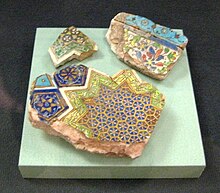
The Golden Horde's elites were descended from four
The Horde developed as a sedentary rather than nomadic culture, with Sarai evolving into a large, prosperous metropolis. In the early 14th century, the capital was moved considerably upstream to
Despite Russian efforts at
Provinces
The Mongols favored
Vassal territories
- Venetian port cities in the Jochids custom duties, and the revenues were divided among all Chingisid princes of the Mongol Empire in accordance with the appanage system.,[176]
- the banks of Azov,
- the country of Circassians,
- Walachia,
- Alania,
- Russian lands.[177]
Genetics
A 2016 study analyzed the DNA of 5 skeletons in
Four of the skeletons belonged to the East Eurasian The authors proposed that R1b is theA 2018 genetic study published in Nature examined the remains of two males buried in the Ulytau District in Kazakhstan c. 1300.[187][188] One male, who was a Buddhist member of the Golden Horde army, was of East Asian ancestry and carried paternal haplogroup C3[189] and the maternal haplogroup D4m2.[190] The other male, who was of West Eurasian (European) ancestry, was a carrier of the paternal haplogroup R1[191] and the maternal haplogroup I1b.[192] According to the authors, this could suggest assimilation of distinct ethnic groups in to the Golden Horde, however he could also be servant or slave.[193]
Coinage
-
Talabuga's coin, dating c. 1287–1291 AD
-
Jani Beg's coin, dating c. 1342–1357 AD
-
Berdi Beg's coin minted in Azak, dating c. 1357 AD
-
Kildibeg's coin minted in Sarai, dating c. 1360 AD
-
Ordumelik's coin minted in Azak, dating c. 1360 AD
-
Muscovite coin minted in the name of Abdullah ibn Uzbeg, dating c. 1367–1368 or 1369–1370
-
Dawlat Berdi's coin minted in Kaffa, dating c. 1419–1421 or 1428–1432 AD
Gallery
-
Golden Horde raid at Ryazan
-
Golden Horde raid at Kiev
-
Golden Horde raid at Kozelsk
-
Golden Horde raid Vladimir
-
Golden Horde raid Suzdal
-
Mongol-Tatar warriors besiege their opponents.
-
Mongols chase Hungarian king from Mohi, detail from Chronicon Pictum.
-
The Mongol army captures a city
-
Mongol invasion of Hungary in 1285
-
Edigu's invasion of Rus
-
Drawing of Mongols of the Golden Horde outside Vladimir presumably demanding submission before sacking the city
-
Paiza of Abdullah Khan (r. 1361–1370) with Mongolian script
-
Mongol-Tatar raid
-
Mikhail of Tver being punished by the Golden Horde
See also
| History of the Mongols |
|---|
 |
| History of Central Asia |
|---|
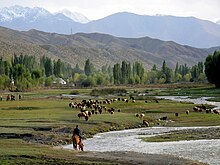 |
- Cumans
- Mongol invasion of Kievan Rus'
- Russo-Kazan Wars
- Tatar invasions
- Timeline of the Golden Horde
- Tokhtamysh–Timur war
- Volga Bulgaria
- Division of the Mongol Empire
- Berke–Hulagu war
- History of the western steppe
- List of Khans of the Golden Horde
- List of medieval Mongol tribes and clans
- List of Mongol states
- Jarlig
Notes
- ^ Their state came to be known in historiography as the Golden Horde or the ulus ("people" or "patrimony") of Djochi, while the contemporaries simply referred to it as the Great Horde (ulu orda).[3]
- ^ "Clearly, the Russian bookmen's posturing notwithstanding, the Mongols were anything but an unknown and unknowable people. The Tatars, as an abstraction, were loathed on principle, but to the Russian elite their Tatar counterparts were far from being nameless, faceless enemies. Indeed, Russian aristocrats were probably more familiar with the higher levels of Mongol society than with the society of the Russian peasantry."[149]
References
- ^ Halperin 1987, p. 78.
- ISBN 978-1-4677-0375-8.
- ^ a b c Kołodziejczyk (2011), p. 4.
- ISSN 2617-1864. Retrieved 1 September 2021.
- ISSN 1076-156X. Retrieved 12 September 2016.
- JSTOR 2600793.
- ^ Fedorov-Davydov, German A. "The Monetary System of The Golden Horde". Translated by L. I. Smirnova (Holden). Retrieved 14 July 2017.
- ^ "The History and Culture of the Golden Horde (Room 6)". Saint Petersburg: The State Hermitage Museum. Retrieved 21 March 2020.
- ISBN 978-0-521-81227-6.
- ^ a b "Golden Horde". Encyclopædia Britannica. 2007.
Also called Kipchak Khanate Russian designation for Juchi's Ulus, the western part of the Mongol Empire, which flourished from the mid-13th century to the end of the 14th century. The people of the Golden Horde were mainly a mixture of Turkic and Uralic peoples and Sarmatians & Scythians and, to a lesser extent, Mongols, with the latter generally constituting the aristocracy. Distinguish the Kipchak Khanate from the earlier Cuman-Kipchak confederation in the same region that had previously held sway, before its conquest by the Mongols.
- ^ ISBN 9780028656939.
- ^ Atwood (2004), p. 201.
- ^ "рЕПЛХМ гНКНРЮЪ нПДЮ - НЬХАЙЮ РНКЛЮВЮ 16 ЯРНКЕРХЪ (мХК лЮЙЯХМЪ) / оПНГЮ.ПС – МЮЖХНМЮКЭМШИ ЯЕПБЕП ЯНБПЕЛЕММНИ ОПНГШ". Proza.ru. Retrieved 2014-04-11.
- S2CID 161222967.
- ^ May, T. (2001). "Khanate of the Golden Horde (Kipchak)". North Georgia College and State University. Archived from the original on December 14, 2006.
- ISBN 978-90-04-17536-5.
- ^ Atwood (2004), p. 41.
- ^ Allsen (1985), pp. 5–40.
- ^ Edward L. Keenan, Encyclopedia Americana article
- ISBN 978-5-8958-9005-9.
- ^ "History of Crimean Khanate". Archived from the original on 2009-01-06.(in English)
- ^ JSTOR 41933117.
- ^ a b c Vernadsky 1953, p. 146.
- ^ Atwood 2004, p. 479.
- ^ Vernadsky 1953, p. 143.
- ^ Martin (2007), p. 152.
- ^ Vernadsky 1953, p. 147.
- ^ Atwood (2004), p. 213.
- ^ Atwood 2004, p. 78, Local censuses also took place in the 1240s in Russia and Turkey... extent of the empire made the census very time consuming; while that of North China was completed in 1252, Novgorod in the far northwest was not counted until winter 1258–59..
- ^ Atwood 2004, p. 48.
- ^ Vernadsky 1953, pp. 148–149.
- ^ Vernadsky 1953, p. 150.
- ^ Vernadsky 1953, p. 151.
- ^ Jackson (2014), pp. 123–124.
- ^ Annales Mellicenses. Continuatio Zwetlensis tertia, MGHS, IX, p. 644
- ^ Jackson (2014), p. 202.
- ^ Vernadsky 1953, p. 153.
- ^ Kirakos, Istoriia p. 236
- ^ Mukhamadiev, A. G. Bulgaro-Tatarskiya monetnaia sistema, p. 50
- ^ Rashid al-Din-Jawal al Tawarikhi, (Boyle) p. 256
- ISBN 978-0-521-36289-4.
- OCLC 845782300.
As the transformation of St. Aleksandr Nevsky from 'son of Suzdal' to 'son of Rus'' in early modern Muscovite literature well attests...
- ^ Vernadsky 1953, p. 163.
- ISBN 978-1-59740-450-1.
- ^ Howorth (1880).
- ISBN 978-1-136-80044-3.
- ISBN 978-1-4464-8615-3.
- ISBN 978-0-8122-1766-7.
- ISBN 978-0-521-52290-8.
- ISBN 978-0-09-178264-1.
- ^ Vásáry 2022, p. 475, only the Russian clergy was tax-exempt.
- ISBN 978-0-226-71843-9.
the role of the Tatars who settled in Russia and were converted to Christianity... case of Tsarevich Peter of the Horde, founder of a monastery in Rostov
- ^ Vernadsky 1953, p. 169.
- ^ Anton Cooper On the Edge of Empire: Novgorod's trade with the Golden Horde, p. 19
- ^ GVNP, p. 13; Gramota#3
- ISBN 978-0-940670-02-0.
- ^ Vernadsky 1953, p. 172.
- ^ Vernadsky 1953, pp. 172–173.
- ^ Vernadsky 1953, p. 173.
- ^ Vernadsky 1953, pp. 173–174.
- ^ a b Vernadsky 1953, p. 174.
- ^ Rashid al Din-II Successors (Boyle), p. 897
- ^ Allsen (1985), p. 21.
- ISBN 978-0-521-81539-0.
- ^ Howorth (1880), p. 130.
- ^ Byzantino Tatarica, p. 209
- ^ Vernadsky 1953, p. 177.
- ^ Vernadsky 1953, p. 178.
- ^ a b c d e f g Vernadsky 1953, p. 185.
- ^ a b c d Vernadsky 1953, p. 186.
- ^ Baybars al Mansuri-Zubdat al-Fikra, p. 355
- ^ Spuler (1943), p. 78.
- ^ Barthold, V.V. Four Studies on Central Asia. Translated by Minorsky, V.; Minorsky, T. Brill. p. 127.
- ISBN 978-0-8135-1304-1.
- ISBN 978-0-07-340693-0.
- ^ Vernadsky 1953, p. 189.
- ^ Vernadsky 1953, p. 190.
- ISBN 978-1-139-44408-8.
- ^ Ptolemy of Lucca Annales, p. 237
- ISBN 978-0-271-04445-3.
- ISBN 978-0-521-06936-6.
- ^ a b c d e f Vernadsky 1953, p. 193.
- ^ Badarch Nyamaa – The coins of Mongol empire and clan tamgna of khans (XIII–XIV) (Монеты монгольских ханов), Ch. 2.
- ^ a b Jackson (2014), p. 204.
- ^ Spuler (1943), p. 84.
- ^ Vernadsky 1953, p. 191.
- ^ Vernadsky 1953, p. 194.
- ^ a b c Vernadsky 1953, p. 195.
- ^ Vernadsky 1953, p. 196.
- ^ Vernadsky 1953, p. 198, Ibn-Batuta, who visited Uzbeg's dominions around 1333, describes Saray as a large and beautiful city with vast streets and fine markets. Six "nations" lived in it—Mongols, Alans, Kypchaks, Circassians, Russians and Greeks–each being assigned a section of its own..
- ^ a b Vernadsky 1953, p. 197.
- OCLC 124025602.
- ISBN 978-0-8122-0107-9.
- ^ Atwood (2004), "Golden Horde".
- ^ Mihail-Dimitri Sturdza, Dictionnaire historique et Généalogique des grandes familles de Grèce, d'Albanie et de Constantinople (Great families of Greece, Albania and Constantinople: Historical and genealogical dictionary) (1983), p. 373
- ^ Saunders (2001).
- ^ Jireuek Bulgaria, pp. 293–295
- ^ Martin (2007), p. 175.
- ^ Fennell, John (1988). "Princely Executions in the Horde 1308–1339". Forschungen zur Osteuropaischen Geschichte. 38: 9–19.
- ^ a b Vernadsky 1953, p. 200.
- ISBN 978-0-520-34758-8.
- ^ Vernadsky 1953, p. 199.
- ^ Vernadsky 1953, pp. 200–201.
- ^ a b c Vernadsky 1953, p. 201.
- ^ Vernadsky 1953, pp. 201–202.
- ^ Vagnon, Emmanuelle (1 January 2020). "Mongols et Tartare dans les cartes occidentales du Moyen Âge". A. Caiozzo et J.-C. Ducène (Éd.), de la Mongolie Àla Mongolie dans Son Espace Régional. Entre Mémoire et Marques de Territoire, des Mondes Anciens À Nos Jours, Valenciennes, Presses Universitaires de Valenciennes. Presses Universitaires de Valenciennes: 145.
- ^ a b Vernadsky 1953, p. 202.
- ^ a b c d e Vernadsky 1953, p. 203.
- ISBN 978-1-107-65876-9.
- ^ Vernadsky 1953, pp. 203–204.
- ^ Ibn Battuta-, 2, 414 415
- ISBN 978-0-300-05167-4.
- ^ "The Cresques Project – Panel V". www.cresquesproject.net.
- ^ a b Vernadsky 1953, p. 204.
- ^ Vernadsky 1953, p. 205.
- JSTOR 4204855.
- ^ Jackson (2014), p. 211.
- ^ Vernadsky 1953, p. 208.
- ^ a b Vernadsky 1953, p. 246.
- ^ Atwood 2004, p. 480.
- ^ a b Vernadsky 1953, p. 258.
- ^ a b Vernadsky 1953, p. 247.
- ^ Vernadsky 1953, p. 250.
- ^ Vernadsky 1953, p. 267.
- ^ a b Grousset 1970, p. 407.
- ^ a b ed. Johann Voigt, Codex diplomaticus Prussicus, 6 vols, VI, p. 47
- ^ Vernadsky 1953, p. 277.
- ^ Howorth (1880), p. 287.
- ^ Vernadsky 1953, p. 282.
- ^ Vernadsky 1953, pp. 284–287.
- ^ Forsyth 1992, pp. 25–26.
- ^ Vernadsky 1953, p. 293.
- ^ Frank 2009, p. 242.
- ^ a b Vernadsky 1953, pp. 296–319.
- ^ a b c d Vernadsky 1953, p. 329.
- ISBN 978-5-906952-38-7
- ISBN 5-89221-075-8
- ^ Christian 2018, p. 63.
- ^ a b Vernadsky 1953, p. 330.
- ^ a b Vernadsky 1953, p. 332.
- ^ "Russian Interaction with Foreign Lands". Strangelove.net. Archived from the original on 2009-01-18. Retrieved 2014-04-11.
- ^ Kołodziejczyk (2011), p. 66.
- ISBN 9785458063685
- ^ Frank 2009, p. 253.
- ^ a b Vernadsky 1953, p. 214.
- ^ a b Halperin 1987, p. 91.
- ^ Halperin 1987, pp. 118–119.
- ^ Halperin 1987, p. 125.
- ^ Halperin 1987, pp. 124–126.
- ^ Vernadsky 1953, p. 222.
- ^ Halperin 1987, pp. 107–109.
- ^ a b Halperin 1987, pp. 111–113.
- ^ Mirgaleyev 2017, p. 347.
- ^ Spinei 2017, p. 405.
- ^ Vásáry 2022, pp. 475–476, ...the basqaqs (the institution called baskachestvo in Russian), collected the taxes instituted by the Mongols, and only the Russian clergy was tax-exempt.
- ^ a b c d e f g h i j Vásáry 2022, p. 476.
- ^ Halperin 1987, pp. 113–115.
- ^ Halperin 1987, p. 50.
- ^ a b Halperin 1987, pp. 50–51.
- ^ Halperin 1987, pp. 89–91.
- ^ Halperin 1987, p. 93.
- ^ a b c Vásáry 2022, p. 477.
- ^ Vernadsky 1953, pp. 233–244.
- ^ a b Vernadsky 1953, pp. 277–287.
- ^ Clifford Edmund Bosworth, The New Islamic Dynasties - A chronological and genealogical manual, Edinburgh University Press, 2012.
- ISBN 978-0-07-340693-0.
- ^ Mantran, Robert (Fossier, Robert, ed.) "A Turkish or Mongolian Islam" in The Cambridge Illustrated History of the Middle Ages: 1250–1520, p. 298
- ^ Christoph Baumer, History of Central Asia, volume 3, pp. 263–270, 2016. He seems to be following Virgil Ciociltan, The Mongols and the Black Sea Trade, 2012
- ISBN 978-0-19-727627-3.
- ^ Halperin 1987, p. 111.
- ^ "Britannica Academic". academic.eb.com.
- ^ Encyclopædia Britannica
- ^ ISBN 9781136808005.
- ISBN 9781136814655.
- ^ Jackson, Peter (1978). The Dissolution of the Mongol Empire. Harrassowitz. pp. 186–243.
- ^ A. P. Grigorev and O. B. Frolova, Geographicheskoy opisaniye Zolotoy Ordi v encyclopedia al-Kashkandi-Tyurkologicheskyh sbornik, 2001, pp. 262–302
- PMID 27627454.
- ^ Lkhagvasuren 2016: Table 2. Y-haplogroups of the male Tavan Tolgoi bodies. MN0376: R1a1a, MN0126: R1b, MN0104: R1b
- ^ Lkhagvasuren 2016: "In the male graves, MN0104 was unearthed holding an ornament, called “Jins” in Mongolia, consisting of a large pearl mounted on a flower-shaped golden base (Fig 2H). MN0126 and MN0127 were each wearing only a single earring that was found under the skull, indicating their higher social status (Fig 2I and 2J); Mongolian aristocratic men usually wore hats adorned with Jins and a single earring in their left ears, confirming that MN0104, MN0126 and MN0127 were all males."..."MN0376 was also believed to belong to a member of the general public, based on the artifacts excavated. The burial artifacts from this grave were all associated with war, including an arrow quiver and arrowheads; his physical anthropological characteristics, including several signs of injury during his lifetime, such as trauma of the left clavicle and a well-developed skeleton, indicate that he was a common warrior [9, 11]."
- ^ Lkhagvasuren 2016: "Four of the 5 bodies were determined to carry the mitochondrial DNA haplogroup D4, while the fifth carried haplogroup CZ, indicating that this individual had no kinship with the others.
- ^ Lkhagvasuren 2016: "Here, we propose that Genghis Khan and his family carried Y-haplogroup R1b-M343, which is prevalent in West Eurasia, rather than the Y-haplogroup C3c-M48, which is prevalent in Asia and which is widely accepted to be present in the family members of Genghis Khan. Additionally, Tavan Tolgoi bodies may have been the product of marriages between the lineage of Genghis Khan’s Borjigin clan and the lineage of either the Ongud or Hongirad clans, indicating that these individuals were members of Genghis Khan’s immediate family or his close relatives." ... "Considering the historical, archaeological, physical anthropological, and molecular archaeological evidence obtained, it seems most likely that the Tavan Tolgoi bodies are members of Genghis Khan’s Golden family, including the lineage of bekis, Genghis Khan’s female lineage, and their female successors who controlled Eastern Mongolia in the early Mongolian era instead of guregens of the Ongud clan, or the lineage of khans, Genghis Khan’s male lineage, who married females of the Hongirad clan, including Genghis Khan’s grandmother, mother, chief wife, and some daughters-in-law."
- ^ Lkhagvasuren et al. 2016"...the geographical distribution of R1b-M343-carrying modern-day individuals demonstrates that descendants of Tavan Tolgoi bodies today live mainly in Western Eurasia, with a high frequency in the territories of the past Mongol khanates."
- ^ Lkhagvasuren 2016: "Coincidentally, the geographical distribution of modern-day individuals matching the Y-haplogroup and haplotype of the Tavan Tolgoi bodies in the regions corresponding to the past Mongol khanates, including the Golden Horde Dynasty and Chagatai Khanate, implies that the modern-day individuals are direct descendants of the Golden family members."
- ^ Lkhagvasuren 2016"Eastern Russian Tatars, Bashkirs, and Pakistani Hazara were found to carry R1b-M343 at unusually high frequencies of 12.65%, 46.07%, and 32%, respectively, compared to other regions of Eastern Asia, which rarely have this haplotype (Fig 3) [40, 42, 43, 49–53]. Interestingly, ancestors of those 3 populations were all closely associated with the medieval Mongol Empire. That is, Russian Tatars and Bashkirs are descendants of the Golden Horde (also known as the Ulus of Jochi) that had been controlled by Jochi, the first son of Genghis Khan, and his descendants during the 12th–15th centuries. In addition, some of the Hazara tribes are believed to consist of descendants of Mongolian soldiers and their slave women after the 1221 siege of Bamiyan under the leadership of Genghis Khan [54, 55]. Similarly, the high frequency of R1b-M343 in geographic regions associated with the past Mongol khanates including the Golden Horde [...] strongly suggest a close association between the Y haplotype R1b-M343 and the past Mongol Empire (Fig 3) [42–44, 49–53]."
- ^ Lkhagvasuren 2016: "The mixing between Mongoloid and Caucasoid ethnic groups inherent in the genetic structure of modern-day Mongolians was also observed in the Tavan Tolgoi bodies. The Golden family members carried mtDNA haplogroups D4 and CZ, mostly found in Far Eastern and Northeastern Asia, respectively, whereas male members of Golden family carried the Y-haplogroup R1b-M343, dominant in Western Europe [41–43]. That is, although members of Golden family were physically Mongoloid, their molecular genealogy revealed the admixture between Caucasoid and Mongoloid ethnic groups. Thus, it is likely that their Mongoloid appearance would have resulted from gradual changes in their appearance from Caucasoid to Mongoloid through generations from their ancestors. Their physical appearance was largely attributed to D4-carrying Mongoloid females who were indigenous peoples of the Mongolian plateau, rather than an R1b-M343-carrying Caucasoid male spouse who had initially moved from Europe to the Mongolian plateau and his male descendants; it is, however, uncertain how and when the admixture between Mongoloid and Caucasoid ethnic groups originated in the Mongolian plateau."
- S2CID 256769352.
- ^ Damgaard et al. 2018, Supplementary Table 2, Rows 23-24.
- ^ Damgaard et al. 2018, Supplementary Table 9, Row 16.
- ^ Damgaard et al. 2018, Supplementary Table 8, Row 81.
- ^ Damgaard et al. 2018, Supplementary Table 9, Row 17.
- ^ Damgaard et al. 2018, Supplementary Table 8, Row 82.
- ^ Damgaard et al. 2018, p. 372: "We also find the presence of an individual of West Eurasian descent buried together with members of Jochi Khan’s Golden Horde army from the Ulytau mountains (see Supplementary Information section 4: DA28 is East Asian and DA29 is European). This could suggest assimilation of distinct groups into the Medieval Golden Horde, but this individual may also represent a slave or a servant of West Eurasian descent attached to the service of the Golden Horde members."
Bibliography
- Allsen, Thomas T. (1985). "The Princes of the Left Hand: An Introduction to the History of the Ulus of Ordu in the Thirteenth and Early Fourteenth Centuries". Archivum Eurasiae Medii Aevi. Vol. V. Harrassowitz. pp. 5–40. ISBN 978-3-447-08610-3.
- ISBN 978-0-521-24331-5.
- Atwood, Christopher Pratt (2004). Encyclopedia of Mongolia and the Mongol Empire. Facts On File. ISBN 978-0-8160-4671-3.
- Christian, David (2018), A History of Russia, Central Asia and Mongolia 2, Wiley Blackwell
- Damgaard, P. B.; et al. (May 9, 2018). "137 ancient human genomes from across the Eurasian steppes". S2CID 13670282. Retrieved April 11, 2020.
- Frank, Allen J. (2009), "The Western Steppe: Volga-Ural Region, Siberia and the Crimea", in Di Cosmo, Nicola; Frank, Allen J.; Golden, Peter B. (eds.), The Cambridge History of Inner Asia: The Chinggisid Age, Cambridge: Cambridge University Press, pp. 237–259
- Forsyth, James (1992), A History of the Peoples of Siberia, Cambridge University Press
- Halperin, Charles J. (1987). Russia and the Golden Horde: The Mongol Impact on Medieval Russian History. Indiana University. ISBN 9781850430575. (1985 edition online)
- Howorth, Sir Henry Hoyle (1880). History of the Mongols: From the 9th to the 19th Century. New York: Burt Franklin. ISBN 9780265306338.
- ISBN 978-1-317-87898-8.
- ISBN 978-90-04-19190-7.
- Lkhagvasuren, Gavaachimed; Shin, Heejin; Lee, Si Eun; Tumen, Dashtseveg; Kim, Jae-Hyun; Kim, Kyung-Yong; Kim, Kijeong; Park, Ae Ja; Lee, Ho Woon; Kim, Mi Jin; Choi, Jaesung; Choi, Jee-Hye; Min, Na Young; Lee, Kwang-Ho (2016). "Molecular Genealogy of a Mongol Queen's Family and Her Possible Kinship with Genghis Khan". PLOS ONE. 11 (9): e0161622. PMID 27627454.
- Martin, Janet (2007). Medieval Russia, 980–1584. Cambridge University Press. ISBN 978-0-521-85916-5.
- Mirgaleyev, Ilnur (2017), "The Golden Horde and Anatolia", in Khakimov, Rafael; Favereau, Marie (eds.), The Golden Horde in World History, Kazan: Märcani Institute of History of the Tatarstan Academy of Sciences, pp. 347–351, ISBN 978-5-94981-254-9
- ISBN 978-5-94981-254-9
- Spuler, Bertold (1943). Die Goldene Horde, die Mongolen in Russland, 1223–1502 (in German). O. Harrassowitz.
- Vásáry, István (2022), "Taxation in the Jochid Ulus", in May, Timothy; Hope, Michael (eds.), The Mongol World, London: Routledge, pp. 468–483, ISBN 978-1-351-67631-1
- Vernadsky, George (1953), The Mongols and Russia, New Haven, CT: Yale University Press
Further reading
- Boris Grekov and Alexander Yakubovski, The Golden Horde and its Downfall
- Sheila Paine, The Golden Horde: From the Himalaya to the Mediterranean, Penguin Books, 1998.
External links
- The Golden Horde coinage (archived 10 January 2016)
- Golden Horde. Archived 27 July 2011 at the Wayback Machine. arheo.manefon.org (the World Archaeology) (in Russian).


